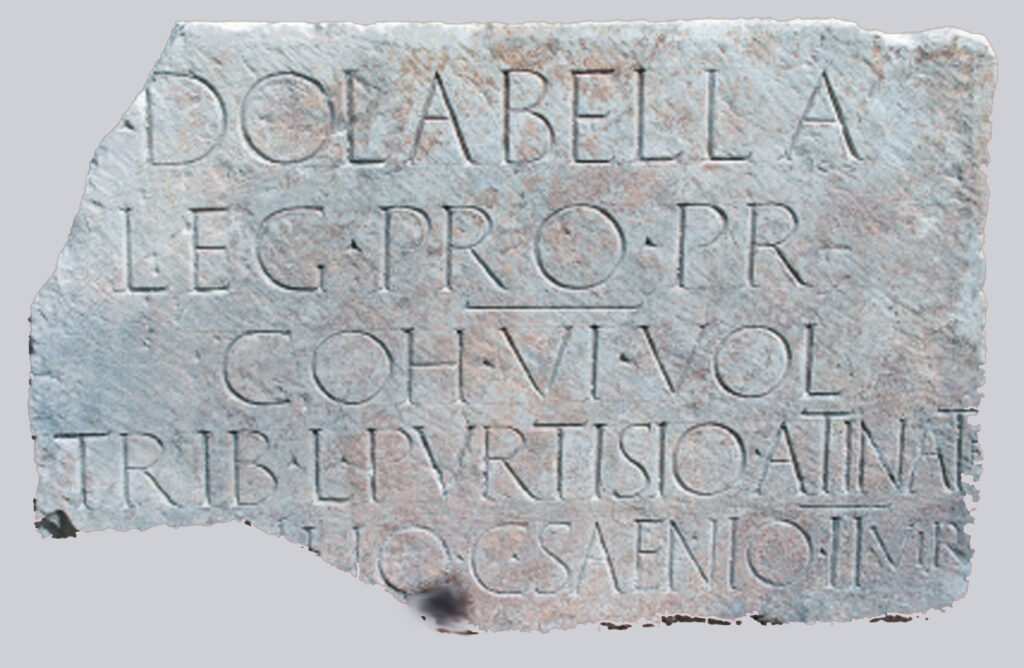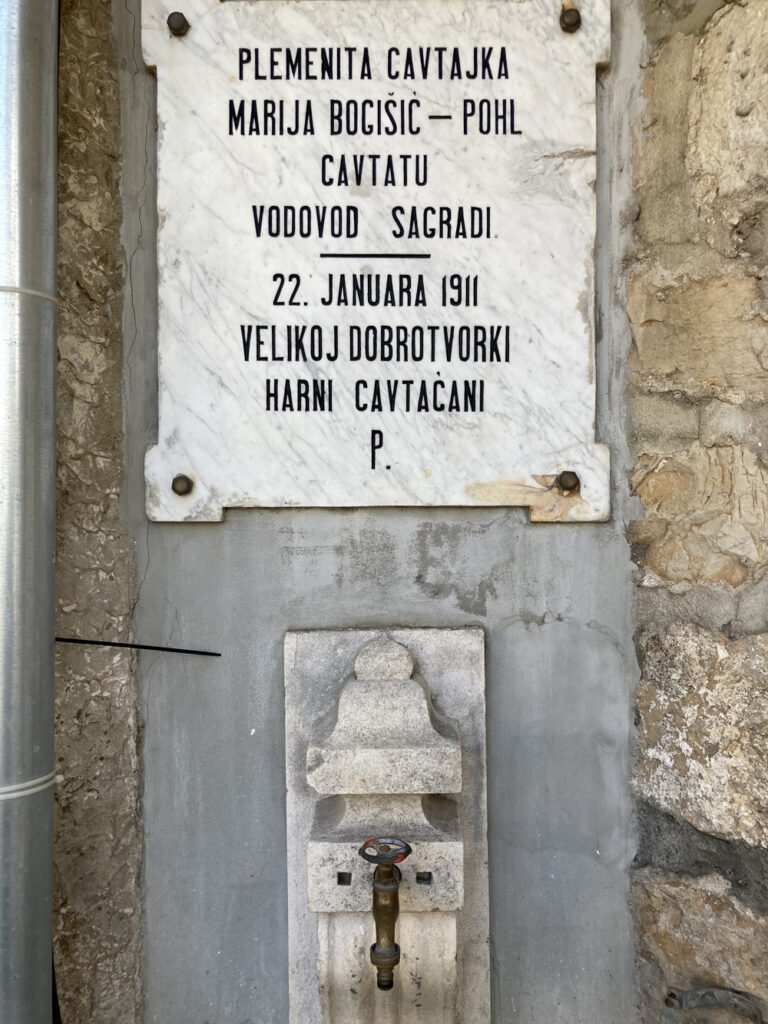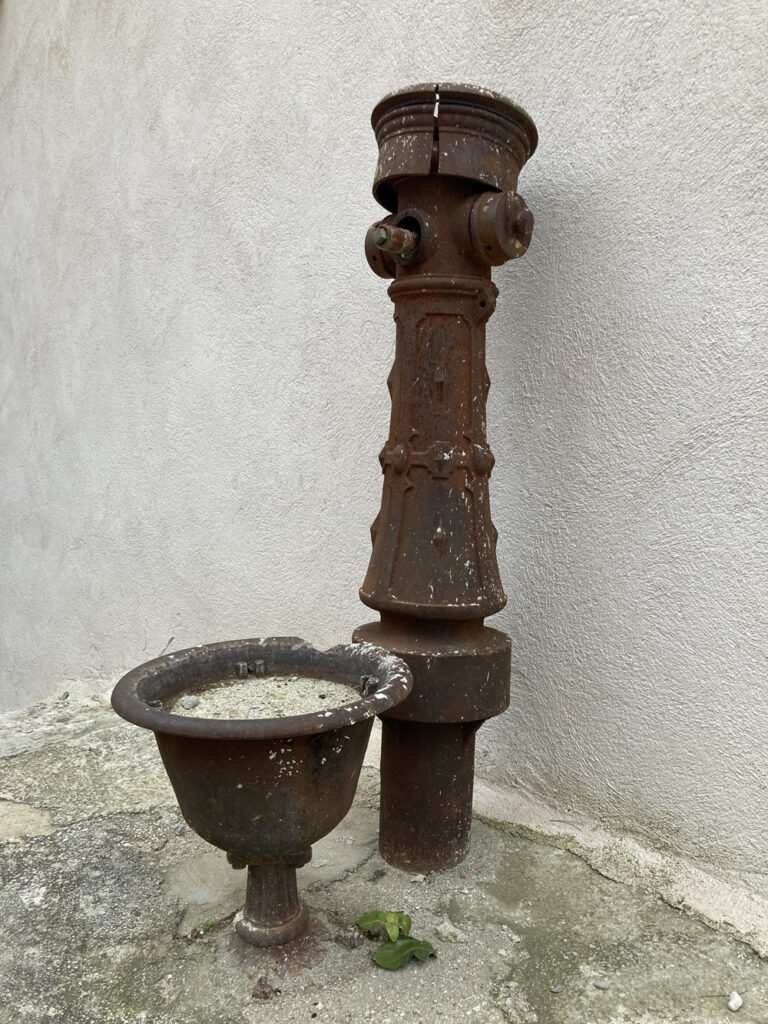
source: Archaeologia Adriatica II
On 22nd January 1911, Cavtat received a water supply system for the second time in its long urban history. The first water supply system, dating back to antiquity, had already been somewhat forgotten. Somewhere between 14 and 20 C.E., during the governorship of Publius Cornelius Dolabella, a large infrastructure project was carried out in the colony of Epidaurum. It was at that time that running water was brought to the centre of the colony from Vodovađa, a village more than twenty kilometres away. An excerpt from an inscription marking the completion of an unspecified construction project financed by the Roman imperial treasury was found in Vuličević Street in Cavtat.
The rest of the inscription informs that Publius Cornelius Dolabella was responsible for the construction works, as well as that the works were carried out by Cohors VI Voluntariorum, a Roman military unit commanded by Lucius Purtisius Atinas. Two city magistrates are also mentioned in the inscription; however, the part specifying the infrastructure project in question is missing. It may be assumed that this project was a water supply system which, apart from its primary function, certainly contributed significantly to the urban landscape of ancient Epidaurum.
One can only imagine the arches of the magnificent aqueduct, of which the substructure in Ulica kneza Domagoja (`Duke Domagoj Street’) is the sole remaining part to this day. The aqueduct once brought running water to the Prijeko street, from where the water supply system continued towards the west of the peninsula. Some of these rows of columns remained in place until the 19th century, when, as Arthur Evans writes, they were demolished in order to widen the road on the occasion of Emperor Franz Joseph’s visit. In any case, the running water delivered by the ancient water supply system was a public good, and as such free for all people.
Many centuries passed, the ancient city disappeared, and a new settlement was formed in its place. That new settlement used rainwater stored in cisterns for centuries and water supply was transferred from the public to private domain. This type of water supply was in use until 1911, as evidenced by an article in the Crvena Hrvatska newspaper:
Cavtat has also not lagged behind with regard to construction of new roads and streets, and the planting of urban green spaces and tree alleys. A great progress has been made in those areas as well. However, the town’s crowning achievement would have to be the water supply system with a memorial fountain, donated to Cavtat by the previously praised Mrs Bogišić.
It is on the now neglected memorial fountain that an inscription detailing the aforementioned donation can be found. The plaque installed by the `grateful‘ people of Cavtat informs that Marija Bogišić Pohl, a noble woman from Cavtat, had a water supply built for her hometown and fellow residents.
Water was piped from Plat to the fountains for public use, which were installed in several places across the town. The new water supply was of great significance to the people of Cavtat. However, the financing of its construction was not the only contribution by the town’s benefactor, Marija Bogišić Pohl. In 1911, the following was recorded in the Cavtat parish chronicle:
The opening ceremony of the water supply, financed by Mrs Marija Bogišić Pohl using her late brother’s inheritance, followed on 22nd January 1911. The blessing of the fountain on the coast by the parish priest was also held on that day.
Cavtat owes a great debt to Marija Bogišić Pohl and her donations. Their gratitude, as well as the general atmosphere on the day of the opening of the waterworks, is best described by the words of the people of Cavtat, whose report of the event’s proceedings was published in the Prava Crvena Hrvatska newspaper on 28th January 1911:
The noble Mrs Marija Bogišić Pohl could not have presented her hometown with a more beautiful, useful or lasting gift than that of a running water supply. The well-known philanthropist had water brought from the retaining walls above Obod at her own expense, and she spent close to 50,000 crowns. On the 22nd of the month, the ceremonial opening and blessing of the waterworks was held. For this purpose, a special committee was established in Cavtat. The committee was presided by the noble Mr Đuro Bijelić, the former Head of the District.
The committee had made sure that the location designated for this solemn act, as well as the entire town, were decorated as beautifully as possible. At half past eleven in the morning, a large number of people from the town and nearby Konavle gathered along with the invited guests and the local authorities. One special delegation was sent for the parish priest, the esteemed Dean N. Štuk, while another was sent for the noble benefactress Mrs Bogišić, who arrived at the ceremony accompanied by twenty young girls dressed in white. Firstly, on behalf of the Committee, Mr Antun P. Bratić held a long speech, in which he greeted Mrs Bogišić and also expressed the immense gratitude of the locals for such a monumental and vital contribution. At the end of the speech, he invited the esteemed parish priest to bless the waterworks. Following the solemn blessing, the benefactress herself held a short speech in which she thanked the Committee and consigned the water supply to the Municipality, to which the Head of the Municipality, Mr Vragolov, replied and thanked her. The waterworks were put into operation and the water soared up to the roof level of the nearby houses. Following that, a plaque commemorating this event and the gift provided by the noble benefactress was unveiled, while young M. Rajčević greeted Mrs Bogišić briefly and gave her a bouquet of flowers. On behalf of the people of Konavle, Mr N. Skurić, greeted Mrs Bogišić and emphasized that the happiness of Cavtat was also the happiness of Konavle. This was followed by a light refreshment for everyone present. The attendees then dispersed, grateful to Mrs Bogišić for such a monument, which will remain in the hearts of the people as long as there is water, from one generation to another.

